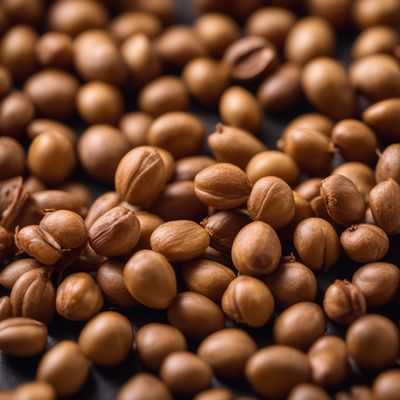
Ingredient
Kersting's groundnut (dry seeds)
The Nutty Delight: Exploring the World of Kersting's Groundnut
Kersting's groundnut is a legume native to West Africa, characterized by its small, round shape and hard outer shell. The seeds have a creamy white or pale yellow color and a dense, starchy texture. When cooked, they become tender and develop a nutty flavor that is reminiscent of peanuts. These dry seeds are commonly used in soups, stews, and porridges, adding a unique taste and texture to the dishes.
Origins and history
Kersting's groundnut has been cultivated in West Africa for centuries and holds cultural significance in countries like Nigeria, Ghana, and Burkina Faso. It is believed to have originated in the region and has been a staple food for many indigenous communities. The groundnut's ability to thrive in arid conditions and its high nutritional value made it an important crop for subsistence farming.
Nutritional information
Kersting's groundnut is a nutritious ingredient, rich in protein, dietary fiber, and essential minerals such as iron, potassium, and magnesium. It is also a good source of vitamins B and E. A 100-gram serving of dry seeds provides approximately 350 calories.
Allergens
Kersting's groundnut may cause allergic reactions in individuals with peanut allergies, as it belongs to the same botanical family.
How to select
When selecting Kersting's groundnut, look for dry seeds that are free from mold, cracks, or insect damage. Choose seeds that feel heavy for their size, indicating freshness. Additionally, ensure that the shells are intact and not discolored.
Storage recommendations
To maintain the freshness and quality of Kersting's groundnut, store the dry seeds in an airtight container in a cool, dark place. They can be kept for several months without losing their flavor or texture.
How to produce
Kersting's groundnut can be grown by amateur gardeners in warm climates with well-drained soil. Start by soaking the seeds overnight, then plant them in rows with a spacing of about 30 cm. Regular watering and weeding are essential for optimal growth. Harvest the pods when they turn brown and dry, then shell the seeds and allow them to further dry before storage.
Preparation tips
Before using Kersting's groundnut, the dry seeds should be soaked in water for a few hours or overnight to soften them. They can then be boiled, roasted, or ground into a flour for various culinary applications. The cooked seeds can be added to soups, stews, or used as a topping for salads and grain bowls. Roasted Kersting's groundnut can be enjoyed as a snack or used as a garnish for desserts. Grinding the seeds into flour opens up possibilities for baking bread, cakes, and cookies.
Culinary uses
Kersting's groundnut is commonly used in West African cuisine, where it is added to soups, stews, and porridges for its nutty flavor and creamy texture. It can also be ground into a flour and used as a thickening agent or as a base for sauces and dips.
Availability
Kersting's groundnut is primarily cultivated and consumed in West African countries such as Nigeria, Ghana, Burkina Faso, and Mali.
More ingredients from this category

Bambara groundnut (dry seeds)
The Hidden Gem of Legumes

Black gram (dry seeds)
The Mighty Black Gram: A Nutrient-Packed Legume

Tepary bean (dry seeds)
The Ancient Bean of the Desert

Mat bean (dry seeds)
The Mighty Mat Bean: A Protein-Packed Legume

Horse gram (dry seeds)
The Nutritional Powerhouse: Horse Gram